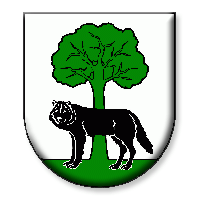The Carpathian Connection - Rudlov (original) (raw)
Village History
Village Photos
Village History
During the second half of the 9th century the area including Rudlov belonged to the Great Moravian Empire. From the 11th century the region was part of the Hungarian Kingdom and the Zemplen Administrative District. Rudlov first appears in documentation during 1402. The first report on the village was dated 1399 and was in regard to property owned between the Abovce-Lipovec estate owners and the nobles of Rozhanovce. During the 14th and 15th century, the village was called Rudelfalva. The village was settled in the mid-14th century and during the 15th century it belonged to the Rozhanovce castle estate called Cicava. During the period of the 17th century the village was owned by the noble families Nadasdiovcom, Nariovcom, Esterhazy and Drugets.
In 1600 there were 21 homes for villagers, a Greek Catholic church and a home for the parish priest. The church was wooden and had a roof of layered shingles. During the first half of the 16th century Rusnaks came to be the majority of inhabitants of the village. They were mainly farmers and had flocks of sheep, lambs and goats. In this area some villagers were also employed in iron ore mining, breading horses and were expert basket makers. The Greek Catholic church was built of stone in 1822 and was constructed by the residents of Rudlov. The church was named the Nativity of the Virgin Mary. The interior of the church would be remodeled during the 20th century. At the turn of the 17th and 18th centuries Rudlov was a medium sized village. Between 1715 and 1720 it listed 16 to 18 peasant households. In 1787 the village has 55 houses and 420 inhabitants. During summer of 1831 a terrible cholera epidemic swept through the village. The first outbreak is documented on July 22, 1831 and killed 54 villagers within a weeks’ time. After this in early August, an uprising began near Trebisov and spread to the villages of Zamutova, Rudlov, Mernik, Cicava, Komarany and surrounding areas. In Mernik, rioters murdered the local magistrate Joseph Sulovsky along with eight other people. Among the murdered was the evangelical pastor Joseph Kacian and District Judge John Revicky. The nobility sent troops to stop the rebellion. Six hundred soldiers were sent to bring the murderers to the court in Vranovce. On August 31, 1831, 41 people were hanged for murder and others sent to prison for their participation in the rebellion. After 1860 the village was owned by the Coudenhoveovcov family.
During the period of 1880 to 1910 many residents immigrated to the United States. In this area there are many mineral springs. A number of small resorts were built prior to the First World War in the surrounding area. The forests in this region hold a number of important plants and flowers. A natural reserve in Rudlov “Zamutovska Jelsina” was begun and this area is a protected state site which encompasses 75 acres. Rudlov had a school built after the Austro-Hungarian School Act of 1868. In 1909 a larger primary school was built and until 1919 classes were held in Hungarian, Slovak and Rusnak. There are five mountain groups that surround Rudlov which are: Simonka, Makovica, Mosnik, Bogota and Milic. The highest peak is Simonka (629 feet). There are a number of meadows and mountain streams surrounding the village and the forests mostly contain oak and beech trees. In 1958 a cooperative farm was begun. During this time others found work in manufacturing plants in Vranove and Hencovce.
Notable Personalities:
Adolf Ivan Dobriansky was born on December 18, 1817 and died March 19, 1901. He was born in Rudlov and was a Rusnak writer, philosopher and publisher. He worked to advance the rights of the Rusnak and Slovak people during Hungarian administration. His father, Jan Dobriansky, was the Greek Catholic parish priest of Rudlov. Adolf’s father came from a long line of Greek Catholic priestly families. He was buried in the Certizne Greek Catholic cemetery on March 25, 1901 in accordance with his Last Will and Testament.
Village Statistics:
In 1414 the name of the village was Reudel. In 1474 Rywdel, in 1773 Rudlyow, in 1808 Rudlow and in Hungarian Rudlyó, Ercfalva. The present name of the village Rudlov has been utilized since 1920.
Acreage:
1,605HA is the size of the village. HA is short for Hektar. 1 Hektar is 2.471 acres.
Greek Catholic Priests Who Served Rudlov:
1826 to 1746, Vasil Dobrjanski, 1796 to 1807, Vasil Ladizinsky, 1807 to 1817, Juraj Kmet, 1817 to 1824, Jan Dobriansky, 1924 to 1946, Peter Viravec, 1846 to 1847, Alexander Demjanovic, 1847 to 1850, Adalbert Bradac, 1850 to 1870, Jozef Danielovic, 1870 to 1888, Andrej Petrasy, 1888 to 1922, Anton Brinsky, 1922 to 1934, Mikulas Takac, 1934 to 1951 Jozef Zelinsky
Village Photos
The following photos provided by, The Greek Catholic Archbishop of Presov
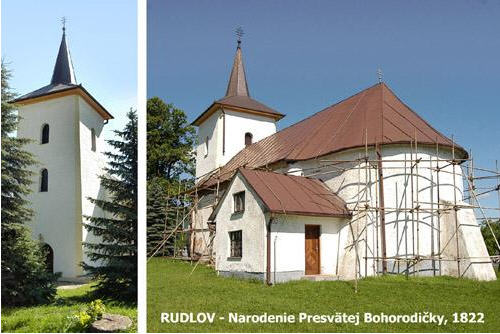
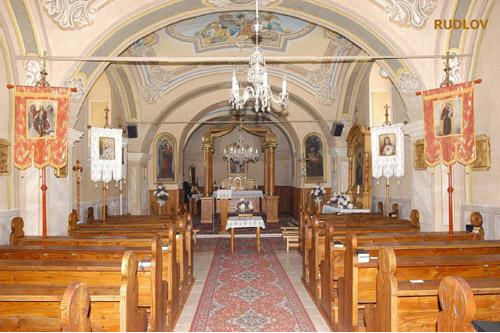
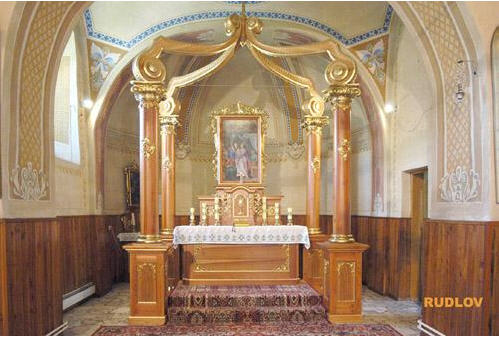
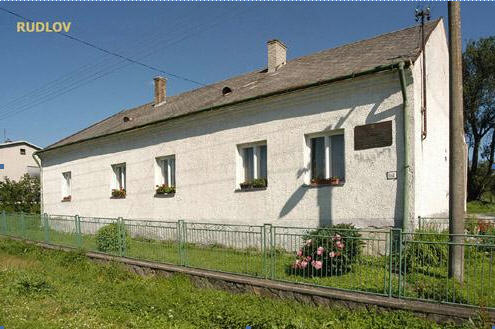
Birthplace of Adolf Ivan Dobriansky
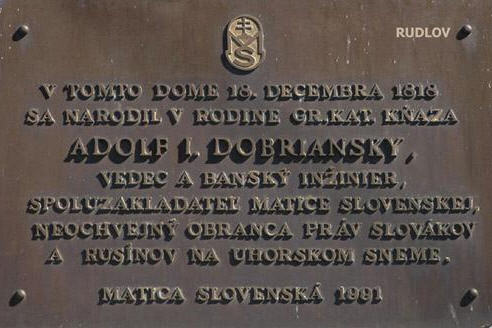
Commenerative Plaque
Translation
In this house 18 Dec 1818 was born in the family of Greek Catholic priests Adolf I. Dobriansky scientist and mining engineer co-founder Slovakia scientific and cultural institution unflinching defender rights of Slovaks and Ruthenians under Hungarian Rule Slovakia scientific and cultural institution in 1991
